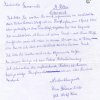Index of Names, buried in the anonym Shaft Graves
Shaft graves at the main cemetery of St. Pölten, Group VI / 1a - 36a
The following persons were determined by Manfred Wieninger (St. Pölten) from the documents of the cemetery management as well as the death protocols and registration documents of the city and reporting archive St. Pölten. For many, only the first and last name and the position in the Schachtgrab are handed over. Where further information was available, the basic data and the place of birth were taken over in the sources. The Jewish burials are listed in the menu point Zwangsarbeitslager Viehofen. Many names include the cause of death and the place of death, the forced laborers and the foreign workers the labor camp. These data are passed on to us on request for scientific purposes or to relatives. Please contact
Murdered in the forced labor camp St. Pölten-Viehofen
Jews from Hungary
Frieda Neumann, geborene Kohn, born 5. 3. 1888 in Szabadka, died 18. 10. 1944
Ing. Paul Vadasz, born 5. 12. 1874 in Szakcs, died 11. 12. 1944
Filipp Hegyi, born 1. 8. 1864 in Okacke, died 2. 1. 1945 (tombstone at the New Jewish Cemetery St. Pölten)
Malvine Hegyi, born 31. 8. 1944 (tombstone at the New Jewish Cemetery St. Pölten)
Dr. Ignaz Körösi, born 2. 1. 1862 in Szentes, died 21. 2. 1945
Edmund Revesz, born 19. 12. 1880 im Chambeg, died 3. 3. 1945
Jakob Genad, born 14. 1. 1870 in Sceged, died 5. 3. 1945
Izso Pottasmann, born 8. 12. 1879 in Beszterze, died 22. 9. 1944
Armin Wolf, born 15. April 1873 in Mako, died 1. April 1945
Died in the Hospital St. Pölten, burried in the mass grave
Herzog Jenö, born 27.9.1902 in Wien, died 22.5.1945
Unknown Jews (Gruppe VI-19)
The forced labor camp in Viehofen
The fact that in Viehofen near St. Pölten a forced labor camp for Hungarian Jews and Jewish women existed, was for more than 60 years displaced and forgotten. It was not until the letter of a young youth, Rószi Wolf, to the INJOEST, that it was known that Jewish families were used as slaves for the management of traits in Viehofen. From 10 July 1944 to 8 April 1945 up to 180 people aged two to over 80 years lived in three barracks and huts.






